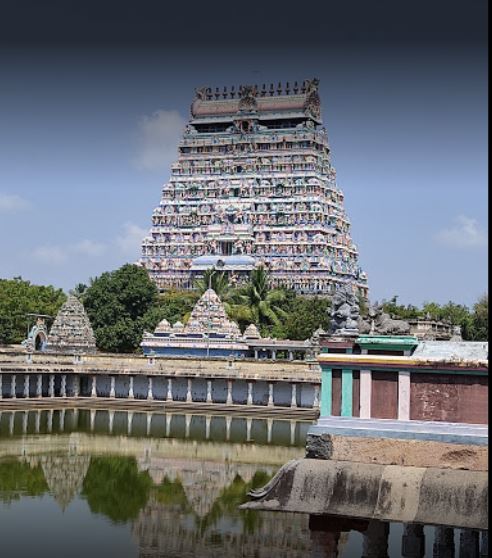Chidambaram Temple :
Nataraja Temple, also known as Chidambaram Natarajar Temple or Thillai Nataraja Temple, is a Hindu temple in Chidambaram, Tamil Nadu, India, dedicated to Nataraja, Shiva as the Lord of Dance. The Chidambaram Temple has mythical origins, and there was a Shiva shrine on the site when Thillai was the name of the region.
Chidambaram Temple is one of the five holiest Shiva temples, each representing one of the five natural elements (aether). Thiruvanaikaval Jambukeswara, Trichy (water), Kanchi Ekambareswara, Kanchipuram (earth), Thiruvannamalai Arunachaleswara (fire), Thiruvanna malai, and Kalahasti Nathar, Kalahasti.
Meaning of Chidambaram : The word Chidambaram is derived from the Sanskrit words chit, which means “consciousness,” and ambaram, which means “sky” (from aakasam or aakayam). It refers to the chidaakasam, or sky of consciousness, which is the ultimate goal of all Vedas and scriptures.
Chidambaram Temple History :
The legend of Lord Shiva strolling into the Thillai Vanam (Vanam meaning forest and thillai trees – botanical name Exocoeria agallocha, a species of mangrove trees – which currently grows in the Pichavaram wetlands near Chidambaram) starts with the legend of Lord Shiva strolling into the Thillai Vanam (Vanam meaning forest and thillai trees – botanical name Exocoeria agallocha, The Thillai trees are depicted in temple sculptures from the 2nd century CE.
In the Thillai forests lived a group of saints known as ‘rishis,’ who believed in the superiority of magic and that rituals and ‘mantras,’ or magical phrases, could control God. The Lord takes the form of ‘Pitchatanadar,’ a simple mendicant seeking alms, and strolls through the forest with resplendent beauty and brilliance. He is accompanied by Lord Vishnu as Mohini, his Grace and consort. The rishis and their wives are enchanted by the handsome mendicant and his consort’s brilliance and beauty. When the rishis see their womenfolk enchanted, they become angered and perform magical rituals to summon a slew of’ serpents’ (Sanskrit: Nga).The serpents are lifted by the Lord as the mendicant and worn as ornaments on his matted locks, collar, and waist. Enraged, the rishis summon a vicious tiger, which the Lord skins and wears around his waist as a shawl. Disgusted, the rishis summon all their divine might and summon the mighty demon Muyalakan, a sign of utter arrogance and ignorance. With a gentle smile, the Lord stands on the demon’s back, immobilizes him, and performs the nanda Thaandava (eternal bliss dance) to reveal his true form. The rishis give up, realizing that this Lord is the reality, beyond magic and rituals.
Chidambaram Natarajar Temple Architecture : The Chidambaram Natarajar temple was built before the Chola period, and its architecture is Dravidian, with the Sanctum Sanctorum resembling Kerala or Malabar style structures. Indeed, the royal charters mention the Sanctum being rebuilt by Kerala architects. The golden roof, on the other hand, with its apsidal form, is a striking example of Vesara architecture. The Chit Sabha and Kanak Sabha, two small buildings, are at the heart of the vast architectural complex. Within layers of concentric courtyards, the temple is spread out over a 40-acre (16-hectare) area. The inner sanctum, its connecting mandapams, and the nearby pillared halls are all squares, stacked squares, or both. There are nine gopurams in the complex, as well as many water storage structures, the largest of which is the Shivaganga sacred pool, which has a rectangular plan. The temple is dedicated to Nataraja Shiva and religious theories aligned with Hinduism’s Shaivism concepts. The temple, however, contains shrines for Devi, Vishnu, Subrahmanyar, Ganesha, Nandi, and others, as well as an Amman shrine and a Surya shrine with Chariot wheels.The plan includes various sabha (gathering halls), two large choultries (100 pillared and 1,000 pillared halls), inscriptions and frescoes narrating Hindu legends about gods, goddesses, saints, and scholars, and inscriptions and frescoes narrating Hindu legends about gods, goddesses, saints, and scholars.
Chidambaram Temple Timings :
Morning : 6.00AM to 12.00PM
Evening : 5.00PM to 10.00PM
Thillai Nataraja Temple Chidambaram Daily Pooja Timings :
Time: 6.30.a.m. PAAL NIVEDHYAM
7.00.a.m. MAHA AARTHI
7.45 a.m.to 9.00.a.m. KALASANDHI POOJA ( first pooja of the day)
10.00a.m.to 11.00.a.m. IRANDAAM KAALAM ( 2nd pooja of the day)
11.30.a.m.to 12.00noon UCHIKAALAM (3rd pooja of the day)
5.15p.m. to 6.00.p.m. SAAYARAKSHAI ( 4th pooja of the day)
7.00.p.m.to 8.00.p.m. IRANDAAM KAALAM (5th pooja of the day)
9.00.p.m. to 10.00.p.m. ARDHAJAAMAM (6th and last pooja of the day)
chidambaram nataraja temple official website : http://www.chidambaramnataraja.org/
chidambaram temple contact number : +91- 9443635280
hotels near chidambaram temple : Hotels, lodges, and rooms in Chidambaram town are available at all price ranges.
How to reach chidambaram temple :
Via Air : Trichy (195 km) and Chennai (195 km) are the closest airports (235Km)
Via Rail : From these locations, Chidambaram is well linked by train and bus routes.Chidambaram is now linked to Trichy and other Tamil Nadu cities by rail.
Via Bus : Buses run frequently from Tamil Nadu, Andhra Pradesh, and Karnataka to Chidambaram.Pondicherry is the fastest way to get to Chidambaram from Chennai (east coast Road). It takes 4 hours to drive from Chennai to Chidambaram.
Temples Near Chidambaram :
Thillai Kali Amman temple
Chathapuram Nathar Temple
Thiruvetkalam temple
Achalpuram Temple
Tirunelvayil
Chidambaram Natarajar Images :


